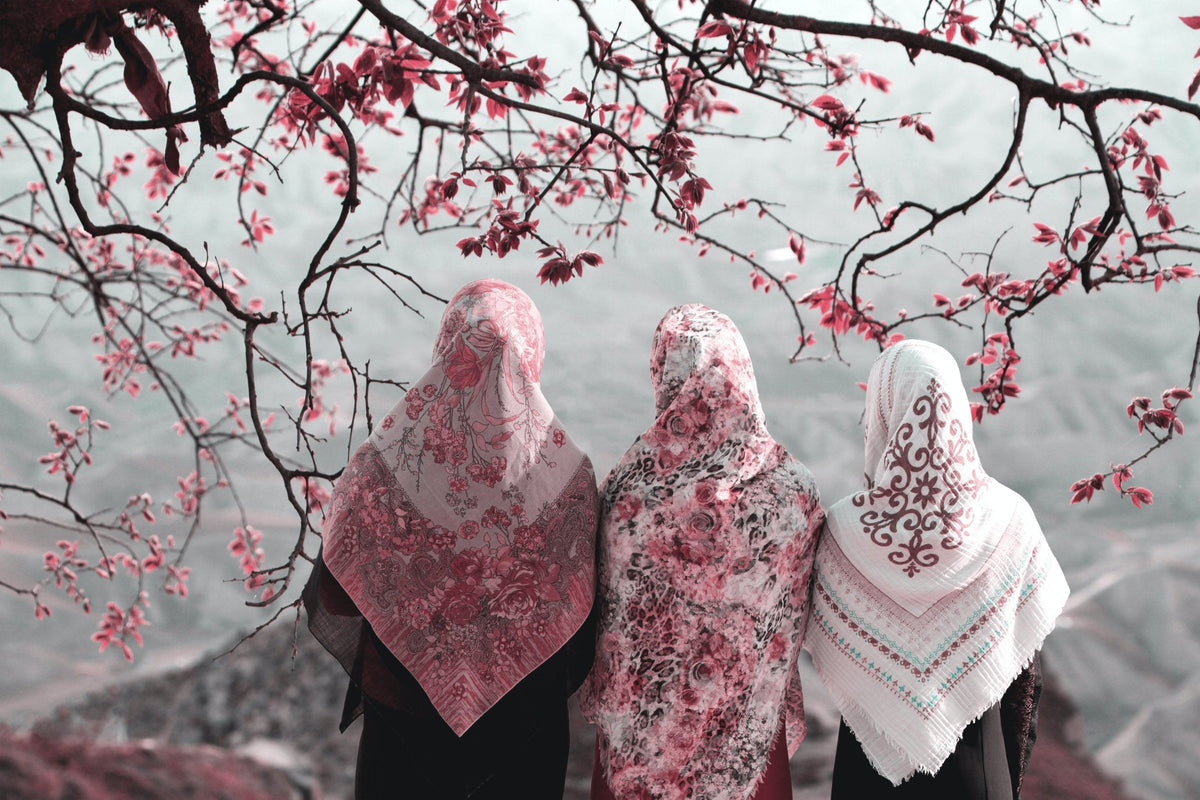

Three people wearing floral veils stand beneath a tree filled with pink spring blossoms. Photo by Hasan Almasi.
RAMADAN IS A TIME OF BLOSSOMING
Spring is in full bloom on the East Coast, just in time for Ramadan (called Ramzan in India), the holiest month of the year. For our Muslim family and friends, this is a season of fasting, prayer, service to others, and looking deep within.
This Sunday is the celebration of Eid al-Fitr, marking the end of Ramadan and its fast. But there’s so much more to this observance that goes beyond fasting. Food, mutual aid and observing the changing seasons are all intrinsic parts of this holiday.
India has the third largest population of Muslims in the world at over 200 million people (that’s more than 10 percent of all Muslims worldwide), so during this month, cities across the country and around the globe are buzzing with activities and glowing with decorative lanterns called fanous that are hung up a symbol of hope, a flickering reassurance of light in the darkness.
Light and dark are integral components of this holiday since fasting and feasting are orchestrated by the rising and setting of the sun.

Multicolored fanous (lanterns) lit. Photo by Rawan Yasser.
WHY RAMADAN MATTERS (EVEN IF YOU’RE NOT MUSLIM)
In the U.S., Muslim holidays are often overlooked by mainstream media and misunderstood among people who come from non-Muslim backgrounds. School age teens often face invasive and sensationalized questions about fasting from their peers, especially during lunchtime (“Aren’t you hungry?!”).
In the workplace and social settings, adults often endure the same tired & tactless jokes year after year (“Maybe I should fast, too!”), and carefully navigate work schedules and dinner invitations.
Even genuinely curious non-Muslims can unknowingly put pressure on an individual person to speak for all Muslims and how they observe Ramadan, which can vary across different cultures and personal preferences.
The best way to learn about Ramadan is to look for online resources written by Muslims, or ask your Muslim friends for their recommendations so you can learn on your own time, not theirs.
In conversation, it’s fine to inquire from someone who knows and trusts you about their particular Ramadan traditions, experiences, and spiritual significance, if they are open to sharing with you. But don’t assume that it is information you are entitled to.

A glass bowl filled with dates. Photo by Rauf Alvi.
ENLIGHTENED FASTING
Ramadan isn’t about the fasting itself. Fasting from food, drink, gossiping, lying, negative thoughts (and sex!) during the daylight hours is a tool to center oneself, look deeper inside and gain a deeper consciousness of God in everyday life.
The morning meal, suhoor, is eaten before sunrise followed by prayer and maybe a few more snoozes on the alarm clock. Suhoor usually includes fruit, porridge or grains, and protein to help sustain people throughout the day.
The evening is a socially active time when the fast is broken and the meal, iftar, is shared among families, friends and neighbors. Mosques host daily communal meals which ensures food for low-income and unhoused people, the elderly, students and anyone who needs a break from cooking. This is one example of Muslims’ increased generosity, food distribution and mutual aid for people in need during Ramadan.
JOYFUL FEASTING
One tradition is common across all Muslim cultures: everyone breaks fast (traditionally, anyway) with eating three dates and drinking water or milk. Dates are packed with energy. Not only are they nature’s candy, they are easily digestible, which is perfect for easing the stomach back into its night shift of digesting food after a full day of vacation.
After the dates, then the feasting begins, building from lighter fare like lentil soups to heartier dishes like layered biryani, meaty stews, crispy tahdig, fresh fish, fried breads, and rich desserts. Food cultures from Palestine and Egypt to Indonesia and Mauritania have their own signature dishes that are popular during Ramadan.
Iftars can be low-key dinners with family, potlucks with friends, or all out block parties with music and dancing. Before the pandemic, some buffet-style iftar meals would be shared between thousands of people seated on ornate rugs outside in long rows, side by side.
Eid al-Fitr is the biggest iftar of them all, with exchanges, special prayers and sermons, community service, and reacquainting with old friends and relatives.
One way we show up for our community is to ensure that our space and the food we serve is inclusive. Our menu is designed not only to be shared, but to accomodate a range of dietary needs and religious restrictions.
We make halal-friendly food, from our vegan and vegetarian dishes to our Haleem (slow-cooked goat), Gushtaba (curried lamb meatballs), and Murgh Khatta Pyaz (Tandoori chicken stew) — all of which meet halal criteria. Plus, our cocktails can be made alcohol-free.
From everyone at the TAGMO team, Eid Mubarak!
